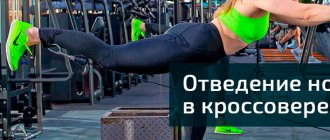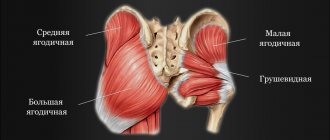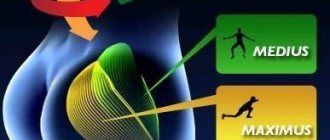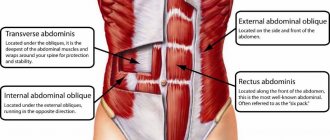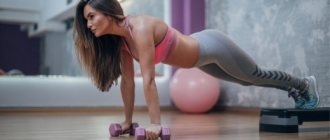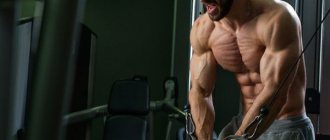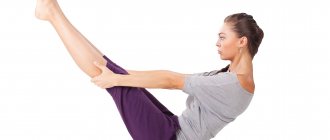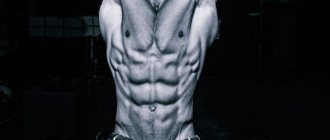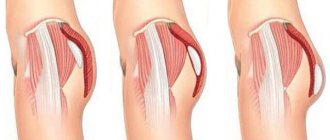The buttocks are sometimes called the lower bust - in the sense that the view from the back should be no worse than the front :o). The gluteal muscle is one of the largest, most spectacular and beautiful on the human body. Frankly, I am lazy to go to the fitness club, I work out at home in my free time from housekeeping.
Training this zone, let me tell you, is the most difficult. You need to constantly listen to your body: turn your leg at the wrong angle, stretch your toe up instead of your heel, and all your efforts are down the drain. ...
This exercise is one of the favorites in fitness centers, enjoys well-deserved respect, and is included in numerous program options for strengthening the buttocks and giving the gluteal muscles the desired shape.
If you follow the correct technique for performing the “Bent Leg Back Swing” exercise, the following muscle groups of the buttocks work, and the auxiliary muscles - the thighs - are also involved.
Leg abduction in crossover
The main muscles that are involved in the work during crossover leg abduction training are the gluteus minimus, medius and maximus muscles. In different versions of the exercise, the biceps of the thigh or the inner surface of the thigh are included in the work.
Read also: Hammam benefits after the gym
If necessary (injuries or medical contraindications), you can replace squats or lunges with crossover swings. When performing this exercise, the joints do not wear out.
To perform various types of leg swings, a crossover is required. This is a universal simulator for block-type training. On such equipment you can perform exercises to work different muscle groups. Additionally, for performing exercises, it comes with equipment: cuffs, ropes, etc.
Crossover
Crossover - a simulator for performing leg swings
What muscles are involved?
Muscles receiving load in crossover swings from the lower block:
- Back : main - gluteus maximus, hamstring muscles, stabilizer muscles - spinal extensors, obliques, gluteus minimus/medius, quadratus lumborum, rectus abdominis ( "Abs": myth or reality? ).
- Forward : front surface of the thigh (quads).
- To the side : what muscles work - gluteus medius, stabilizers, inner thigh (adductor).
You will learn about the advantages of performing exercises with one leg and their effect on the gluteal muscles from the article “ Romanian deadlift on one leg with a barbell or dumbbells: developing the buttocks
Execution technique
Backward leg swings in a crossover can be performed while standing or with emphasis on your hands and knees. Let's first consider the first, most popular option:
- Stand facing the support of the block machine.
- Attach a cuff to the cable of the lower block, which will allow you to secure the cable to your foot or ankle. Place your leg through the cuff.
- Comfortably grasp the support of the simulator with your hands and secure the body. The pelvis should be strictly above the foot of the supporting leg.
- Bend your working leg slightly and swing back. Remember that the gluteal muscles are able to move the straight leg back 10-15 degrees from the vertical line. Then the back muscles come into play. Therefore, if you keep your body straight, do not move your leg too far and do not bend.
- Do not turn your hip outward; the movement is performed strictly backward.
- At the top of the movement, pause briefly and lower your leg to the starting position.
If you keep your body straight, you don’t need to move your leg far.
By tilting your body forward, you can adjust the amplitude of your swing. Accordingly, the lower you bend, the greater the amplitude of leg movement will be. Accordingly, the gluteal muscle will stretch more and work more efficiently. Do not forget to control your back - a natural arch in the lower back is allowed, but nothing more. There is no need to arch your back.
Tilt of the body allows you to increase the amplitude of movement.
If you place a small support under your supporting leg, for example, a weight plate, you will be able to swing with a relatively straight leg, practically without bending it at the knee.
Swing your leg back on the floor - straight leg option
Starting position: standing on one knee with emphasis on your elbows and forearms.
Bring the knee of the working leg under the chest - inhale and move the leg bent under the chest back until the hip is completely straightened.
This exercise, performed with a straight leg, develops the ischial-popliteal muscles and gluteus maximus. With the knee bent, only the gluteus maximus muscle is developed, but less intensely.
The upper phase of the movement in this exercise can be performed with large and small amplitudes. At the end of the movement, you can linger in isometric tension for 1-2 seconds.
Training program for buttocks in the gym
Before you begin your glute workout, do light cardio for 5 to 10 minutes, as well as dynamic stretching with exercises such as leg swings, superman kicks, and hip rotations.
| Exercise | Number of approaches | Number of repetitions |
| Hack squats | 4* | 10-12 |
| Lunges forward with dumbbells with leg lifts back Lifts on a bench with dumbbells | 4 4 | 10-20 for each leg 12 for each leg Read also: What is the calorie content of a pear and an apple? |
| Bulgarian split squat with dumbbells | 4 | 10-12 for each leg |
| Raising the pelvis with a barbell | 4 | 12-15 |
| Swing your legs to the sides in a crossover | 4 | 10-15 |
| Swing your legs back in a crossover | 4 | 12 for each leg |
*not counting 2 warm-up approaches without weights
Inclusion in the training plan
Crossover leg swings are an additional practice that usually complete a complex training session for the hips and buttocks after the main exercises. Back swings are what you need to “finish off” the already well-warmed muscles of the buttocks and the hamstrings. Much less frequently, the exercise is performed at the beginning or middle of a training session. This is the so-called pre-fatigue method, when a lagging muscle or muscle group is activated by an isolated load, and only then receives a base tension.
The recommended number of approaches per workout is 3-4 for each leg, repeated 15-20 times. The load weight should be light, since the result is achieved through repeated repetitions. With a large weight, it will not be possible to achieve the correct execution technique, plus there will inevitably be jerks during the swing, which will not have a good effect on the muscles.
To achieve the best effect, it is recommended to combine abduction with exercises for the gluteus medius muscles. These include, for example, hip abduction to the side, performed in the same crossover. After returning to the starting position, it is better to move your working leg slightly behind the supporting leg so that the two feet slightly cross each other.
- A common mistake when doing crossover abduction is lifting the leg too high. Because of this, a large load falls on the lower back, which in theory is not used at all. That is, the buttocks and hamstrings do not receive the necessary tension. The back should be as fixed as possible, only the leg works.
- Heavy weight, fast pace, jerking: all this is also ineffective for pumping up the gluteal muscles.
- If you can only practice crossovers in the gym, but you want to practice at home, it is recommended to use elastic bands. In a standing position, the tape is put on both legs above the knee, and in the palm-knee position - on the feet.
- For girls: this exercise alone does not remove fat by itself. Everything works comprehensively: proper nutrition, jogging, basic exercises. Swings pump up the buttocks and thighs, and are not a magic wand against fat deposits.
To the gluteus maximus muscle
It’s not for nothing that the gluteus maximus muscle received its name. This is the largest muscle of the gluteal region, located superficially, so it largely affects the relief of this part of the body. It covers the rest of the muscles, and the main function of extending the limbs and holding the body in an upright position rests on it.
Therefore, when working out the lumbar-gluteal region, attention should be paid to pumping the gluteus maximus muscle. Especially if the goal is elasticity and a rounded shape. To pump up your gluteal muscles, use simple but effective exercises from the complex below.
Lunges
It’s difficult to do without lunges if you want to increase the size of your buttocks and create a rounded shape. Beginners can perform the exercise without additional weights, but if you have little experience in performing physical exercises, it is better to do lunges with a light weight, gradually increasing it. It is not necessary to purchase special shells; you can pick up a bottle of water or sand.
Performing exercises for the buttocks at home:
1. The body is straight at any point of the lunge. We take weights in our hands; they will help keep the body in a straight position and simultaneously give a load to the upper body.
2. Lunge, starting with the right foot. At the same time, the left one bends at the knee, but without touching the floor with the knee - the shin should remain parallel to the floor, the angle at the knee should be 90 degrees. Then we return to the starting position. We continue to repeat 15-20 times, then change legs and perform similar actions.
Straight leg swings + cross swings
It is better to do swings with a straight leg and a bent knee alternately; after these two exercises, the muscles will begin to burn. Even beginners will be able to feel the effectiveness of the complex from the first workout.
Technique:
1. Starting position - on all fours. The back is straight, the body and abs are tense.
2. Straighten one leg at the knee and move it back to its maximum height. We make several upward swings, trying to increase the distance from the floor to the maximum point. We put the leg in place, repeat the movements on the other leg.
3. For beginners, the basic number of repetitions is 25-30 on each leg. We do 2 approaches.
4. During the last approach, we do not place the straight leg on the knee, but lift it behind the foot, which is on the floor. We lift it up again and move it to the side. We do 25-30 repetitions. For high-quality development, it is better to combine it with swings with a bent leg, performing immediately after the last swing with a straight knee.
Pulsating swings with the leg bent at the knee
The starting position is similar to the previous options - on all fours. Raise your legs one by one, move them back, and the angle at the knee should be 90 degrees. The foot should be at a right angle relative to the shin. We fix the position, then try to raise the leg as quickly as possible with pulsating movements as high as possible from the floor.
These are the most effective exercises for the buttocks. When it becomes easy to perform 4-5 sets of 30-40 times, you can use an expander for additional load.
Pelvic lift or “bridge”
The glute bridge is different from the gymnastic exercise known from physical education classes. Starting position: lying on your back. Feet rest on the floor, knees bent, arms extended along the body. From this position, straining your buttocks as much as possible and your legs as minimally as possible, you need to lift your lower back off the floor. There is no need to try to do it high, you should be comfortable in this exercise.
For advanced players there are several options for complications:
• raise your hips on one leg, the other extended along the body;
• raising the hips when one leg rests on the knee of the other.
You can proceed to complex execution options only after completely mastering the basic technique.
Bulgarian lunges
A very effective exercise for pumping, as well as working on body imbalances. It is better for beginners to master the technique first, and experienced athletes who want to diversify their workout can do it with dumbbells or a barbell. To perform this you will also need a low chair, sofa or bench.
To perform the exercise, you need to stand close to a bench or chair and take the widest possible step forward. After this, one leg needs to be placed on a support, so that your toes rest on it. The second leg is on the floor, the emphasis is on the heel.
From this position, perform a deep squat so that the buttocks are approximately in line with the knee of the leg on the floor. Using the heel of the supporting leg, you then need to push the body up. For greater efficiency, it is not recommended to fully extend the leading knee, so as not to remove the load from the muscles.
Smith machine squats
The Smith machine is a bar with two hooks on the sides, respectively, mounted on two racks. During the exercise, the vector of movement of the bar is invariably directed along the racks. The technique of squats in the simulator is the same as in regular squats, but there are a number of nuances.
You need to stand under the bar so that you are exactly in the middle and there are no distortions. The placement of the hands on the bar should also be symmetrical. The elbows are directed slightly downwards, the shoulder blades are brought together. A slight emphasis on the bar with your shoulders. With the help of the Smith machine, it is possible to squat with the most precise angle radius: 90 degrees in the shin, 90 degrees in the pelvis. The squat technique here is clearer due to the directed vector of movement of the bar.
Also, in the Smith machine, squats on one leg are possible; for this, the second leg must be placed on the knee of the first leg.
Smith machine squat technique
Crossover exercises for the pectoral muscles
The main technique in the crossover to the chest is to bring the arms together. Provides complete treatment of the entire chest area. Due to the work of the joints, the muscular component of the chest works at full strength.
The specifics of the exercise are as follows:
- Select the desired load (weight). It is always recommended to start with minimal loads. It should be the same on both sides of the frame.
- We lean forward a little, feet shoulder-width apart, knees in a squat. The leg can be placed forward for better fixation of the body. In this case, the right and left legs will need to be alternated during the exercise.
- We take the handrails of the upper blocks with our hands, the back is straight, the elbow joints are bent.
- Let's take a breath. As you exhale, maintaining the position of your arms and back, bring your arms together at hip level. We fix the position of the body for a few seconds.
- We return to the original position.
It is necessary to perform 3-4 approaches of 12-15 times.
If our main goal is to work the upper pectoral muscles, then this exercise should be performed from the lower block.
- The torso is in a standing position, arms are moved slightly back, elbows are bent. The handles are attached to the lower links.
- As you inhale, raise your arms and bring them together in front of you at stomach level.
- We fix the position and hold it for several seconds. It is important to feel the tension in the back muscles to be sure of the correct technique.
- Then we return to the starting position.
It is important to control the exercise technique and avoid transferring the load to the hands and forearms.
These exercises can and should be combined and alternated in one workout. This will ensure maximum development of the back muscles.
How many sets and repetitions should you do?
Beginners are recommended to start with 12-15 repetitions, 2-3 sets. The main thing is that the working weight is small, for example, 5 kg dumbbells, or an empty barbell.
First you need to understand how to do basic exercises correctly, learn to feel the muscles and accustom them to the load. Then everything depends on the specific goal.
- To lose weight, you should choose a small working weight, about 20 kg, and do 20-25 repetitions. You need to move to heavier weights gradually, for example, over the course of a month.
- To pump up gorgeous legs and butts, you need more serious weights, from 30 kg and above, with 10-12 repetitions done. With whatever maximum weight you can do these 10 movements, take it.
The importance of proper nutrition
If you continue to eat everything, the effect will, of course, be there, but slowly, and not at all as obvious.
- Those who want to reduce their thighs should count calories.
- Those who dream of a butt like a fitness guru should eat more proteins and slow carbohydrates, they are necessary for muscle growth.
Crossover back exercises
An effective exercise is a pullover in the upper block of a crossover (exercises from the “traction” category). Involves all back muscles with emphasis on the latissimus. This exercise helps to create a beautiful, muscular and proportional back.
- We use a handle or bar for crossover rows.
- Facing the frame, we take the handle in the position from above. Arms are straightened. Legs in a light squat position. We move the body back.
- Let's take a breath. As you exhale, using only the back muscles, lower the bar until it contacts the hips, fix the position for a few seconds.
- As you exhale, we return to the starting position.
Important!
- do not allow your elbows to bend. This transfers the load from the back to the biceps.
- Avoid straightening or excessively arching your back.
We perform 3-4 approaches 10-12 times, depending on the level of training and working weight.
There are also the following types of pullover in a crossover:
- chest pull in crossover – upper block;
- traction in a crossover on the back behind the head in the upper block.
The peculiarity of the crossover exercise technique is that the pull is also performed using the back muscles, but it is especially necessary to carefully control so that the load does not transfer to the shoulders and arms. The shoulder blades should be completely brought together and fix the position of the back for 2-3 seconds.
Wide-grip lat pull-down while sitting on an incline bench
Dumbbell lateral raises. lifting dumbbells from the sides. swing your arms with dumbbells
Target muscles: latissimus dorsi (focus on the lower part).
Execution order:
adjust the angle of the bench in the range from 30° to 70° (change the set position before each approach or new workout); attach a V-shaped handle to the cable (if possible, try to find one that is wider than the bench at the top); Grasp the handle with your palms and carefully return back to the base of the bench; While continuing to stand, to stabilize the position, tilt your chest towards the top of the bench, place your legs behind the line of your back; begin to pull the handle towards the lower abdomen, slightly arching your back, keeping your elbows close to your body and your chest raised high; control the traction force so that the shoulder blades are brought together as much as possible.
Targeted object: clavicular head of the pectoral muscle.
How to do the exercise:
- set the bench at an incline of approximately 75°;
- place it centrally inside the simulator;
- adjust the cables so that when you grip the handles, your shoulders are at an angle of about 70° in relation to your torso;
- from a standing position, lie with your back on the bench;
- clasp the handles with your palms;
- Having slightly bent your elbows, begin to bring your arms across your body and slightly upward, so that when they meet, they are approximately at the level of your nose;
- hold in this position for 1-2 seconds, squeezing and straining your pectoral muscles;
- gradually relaxing the muscles, slowly return to the starting position.
Results. The exercise is a kind of hybrid of the lower row in the crossover and the pinch of the arms in the butterfly machine. However, because it creates a unique plane in which the movement occurs, it stimulates the muscles of the upper chest (just below the collarbone) well.
- set the bench to an inclination angle of approximately 45°;
- install the bench in the crossover so that the distance between its end part and the center of the machine is 60-90 cm (when you lean back on the bench, your head should be closer to the weight than your legs);
- Attach a horizontal handle or rope handle to the cable, which must be interchanged before performing each new approach or at the beginning of the next workout;
- sit down and lean back on the bench, ask the assistant to give you the handle;
- elbows spread out to the sides should be in line with the torso (they must be held in this position throughout the entire set);
- Instead of lowering the handle straight down, you will have to perform a movement that combines elements of extension and thrust at the same time;
- continue the movement until the muscles contract completely and hold this position for 1 second;
- slowly return to the starting position.
Result: the exercise, being a combination of triceps rows and extensions, combines the best of them in terms of enhanced impact on the triceps.
- grab the end of the cable of the upper block (preferably the tip);
- bend towards the floor at a right angle;
- bend your legs slightly, place the elbow of your non-working arm on your knee;
- hold the cable so that the movement can be performed with a hammer grip;
- starting with the triceps, at full stretch, slowly straighten your elbow until your arm is straightened and the triceps are fully contracted;
- hold in this position for 1-2 seconds;
- return to the starting position.
Why do this? The unique positioning of the arm and torso makes this exercise similar to concentrated biceps hammer curls. When the movement is performed absolutely correctly, the triceps muscles contract extremely strongly, which ensures rapid mass growth.
Benefits of Exercise
- Isolated workout of the gluteal muscles. This allows us to load exactly the area we are planning.
- Allows you to load the pelvic muscles without engaging the quadriceps, which is very important for girls who do not want to have large and voluminous hips.
- The crossover does not fix the trajectory along which the leg will be abducted, which allows smaller pelvic muscles to be involved in the work.
- Pulling the leg back can be performed as an alternative to SQUATS in case of injury to the knee joint, since there is no load on it.
- The technique of the exercise is very easy to master, so even beginner athletes can do it.
- There is virtually no load on the spine; only one joint, the hip, is involved in the work.
- Strengthening the gluteal region, resulting in increased weights in basic exercises.
- The ability to work each gluteal muscle independently, thereby minimizing the imbalance in their development.
There are no shortcomings in this exercise, unless, of course, you compare it in terms of effectiveness with the basic ones.
Abs workout
In modern bodybuilding magazines, refusal to train the abs is often promoted. Indeed, the rectus abdominis muscle is loaded when we deadlift or squat, and stretched when we perform a technically correct bench press.
Now let's imagine a newbie. He does squats with a mop stick to develop the skill. He pulls it for the sake of ideal angles. Presses - empty bar. He lacks flexibility, and this is completely normal. You won’t be able to “pump up” your abs at the same time as learning basic exercises.
Why download it?
For beginners and those engaged “for themselves and for health,” abdominal training performs the following functions:
- Helps relieve stress from the spine in basic exercises. Strong abs will take on part of the weight of the barbell; it is advisable to make the abs strong before the barbell becomes heavy;
- Relieves back pain due to muscle spasms;
- Aesthetically looks better than a round belly
Security forces work out their abs to avoid injuries due to back hypertonicity. Runners – for greater core stability during movement and more efficient footwork. Bodybuilders - for beauty. And those who lose weight go to the point of exhaustion, and this is just wrong. It is quite easy to tone the rectus and transverse muscles;
When
If the workout is strength training, it is worth doing light abdominal exercises at the beginning, while activating the muscles. This means training with basic exercises. Then a couple of sets of hyperextensions and a couple of sets of crunches will help you warm up, improve mobility, and get your core engaged before you put the barbell on your shoulders and start squatting with it. By the way, this warm-up is also suitable for bench presses and deadlifts. But activating the abs and training them are two different things. Typically, strength athletes also perform weighted crunches 1-2 times a week to work the rectus muscle.
It makes sense for fitness enthusiasts to do crunches at the end of the session. This will allow you to work out the remaining muscles efficiently and not miss the abs, because if the program is already installed, you will not violate it.
Important: Ab training may not be a “cool down” for most people. Strength training should be completed with light walking, fitness training should also be completed with stretching, if there are no contraindications.
Those who want to develop strength stretch their muscles on a separate day. The purpose of the cool-down is to improve tissue circulation and recovery. Twisting won't help here.
How often to train your abs
Opinions differed. Some athletes believe that the abs are something like the calf muscles, they need to be trained every day, since they are durable and do not respond well to traditional movements for hypertrophy. Others say that the abs need to be worked out like other muscles. For “abs” - with weights or turning on static modes, but not every day, but through training. For relief - in a multi-repetition mode, and every other day. Still others believe that one abdominal workout per week is enough, but it should be hard.
Some people train their abs every day at home, as was previously recommended in martial arts and athletics. In fact, the result and style of training depend to a large extent on individual structural characteristics. You can try different options and see what gives the best result.
Crunches \ Pumping up the Abs \ Exercise for the Abs
Benefit
For slimming thighs and thighs
Do swings help you lose weight in your legs? Indirectly, yes, like absolutely any activity, including walking, making love, and even picking your nose, if it helps you create a calorie deficit
